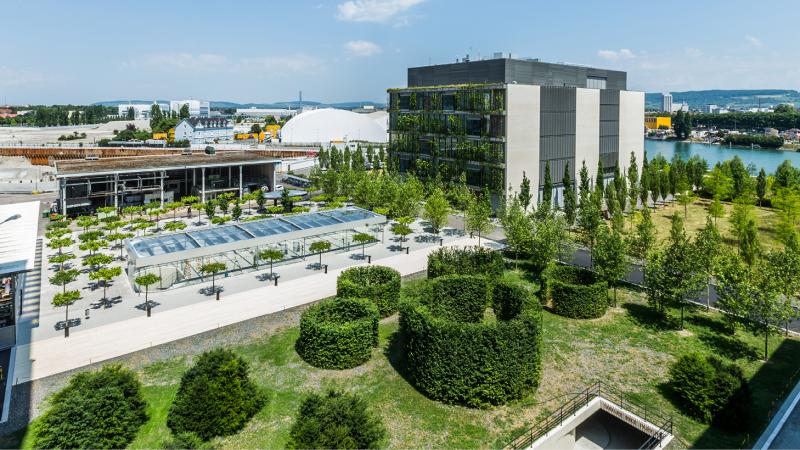Novartis Square and Pavilion
The Square and Pavilion are the latest additions to the Novartis Campus in Basel, Switzerland. Designed by Good Form Studio—jointly led by Assistant Professor of Architecture Andrew Cruse and Professor of Landscape Architecture and Section Head Dorothée Imbert—the project seamlessly merges architectural and landscape interventions to create a new type of workspace for Novartis employees. The campus masterplan, devised by Italian architect Vittorio Magnago Lampugnani, has transformed a site of pharmaceutical production into a hub for research, and in doing so has created a showcase of contemporary architecture and landscape. Research and office buildings by Seijima & Nishizawa (SANAA), Frank O. Gehry, David Chipperfield, and Herzog & de Meuron address plazas, and parks by Peter Walker, Günther Vogt, and Kathryn Gustafson, to name a few.
Responding to the master plan’s open-space strategy, the Square and Pavilion create medium- and small-scale spaces to complement existing larger ones. The two-acre Square sits above an underground bicycle garage (designed by Swiss architect Marco Serra) and offers distinct experiences both indoors and out. To the north is an expansive gravel court defined by the horizontal canopy of a quincunx grove of linden and plane trees interspersed with flowering cherries. To the south, a wide wood boardwalk links the western part of the campus to the Rhine River to the east, and offers a viewing platform to the circular garden rooms beyond. These rooms are defined by tall clipped hornbeam hedges, and alternate with dense masses of yews to create a layered composition. “As you look at the hedge rooms from outside, the overlap between their individual forms creates perceptual ambiguity, and suggests a deeper space,” Imbert said. “In the winter, the filigree structure of the hornbeam branches contrasts with the dark density of the yews, highlighting the void of the rooms and the solidity of the blobs.” Spaces inside the hedge rooms create a sense of enclosure and privacy. Furnished with chairs and tables, they can be used by small groups for informal meetings.
The Pavilion is surrounded by low-iron glass, and visually merges space of the quincunx. The height of its narrow parapet matches that of the surrounding tree canopy. The parapet conceals the Pavilion’s structure and hardware for the one-by-three-meter glass panels, which hang without edge connections. These panels can slide and stack to create wide openings in good weather. Exterior retractable roof shades help to maintain a comfortable climate inside the pavilion during warmer months. As the temperature drops, the panels are closed to trap warm air within the pavilion. Cables supporting bignonia vines create a light green ceiling that mirrors the leafy canopy of the quincunx, further contributing to the continuity between interior and exterior spaces. The Pavilion is a unique in-between space on campus that can be used during swing seasons and in inclement weather. “It provides a warmer space when it’s cool, and an outdoor space when it’s raining or snowing. It can also house a temporary café or buvette, as well as serve as a venue for events,” Cruse explained. In a fundamental way, this project is an extension of Cruse’s research on the connections between architecture, climate and energy: “The Novartis Campus project relates to work that I’ve been engaged with at the Knowlton School: making spaces that provide types of comfort that you wouldn’t typically expect, whether you are inside or outside of a building.”


